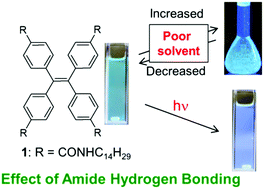Alkylamide-substituted tetraphenylethylene: three modes of fluorescence based on a hydrogen-bonded excimer†
Abstract
Three modes of emission, with different intensities and wavelengths were observed in tetraphenylethylenetetraamide 1 depending on the solvent, concentration and continuous irradiation with light, where intermolecular hydrogen bonds between amide units played a significant role. Limitation of the motility of molecule 1 in the excited state by intermolecular hydrogen bonding is the key for observation of fluorescence even in the solution and transformation to the corresponding 9,10-diphenylphenanthrene derivative.


 Please wait while we load your content...
Please wait while we load your content...